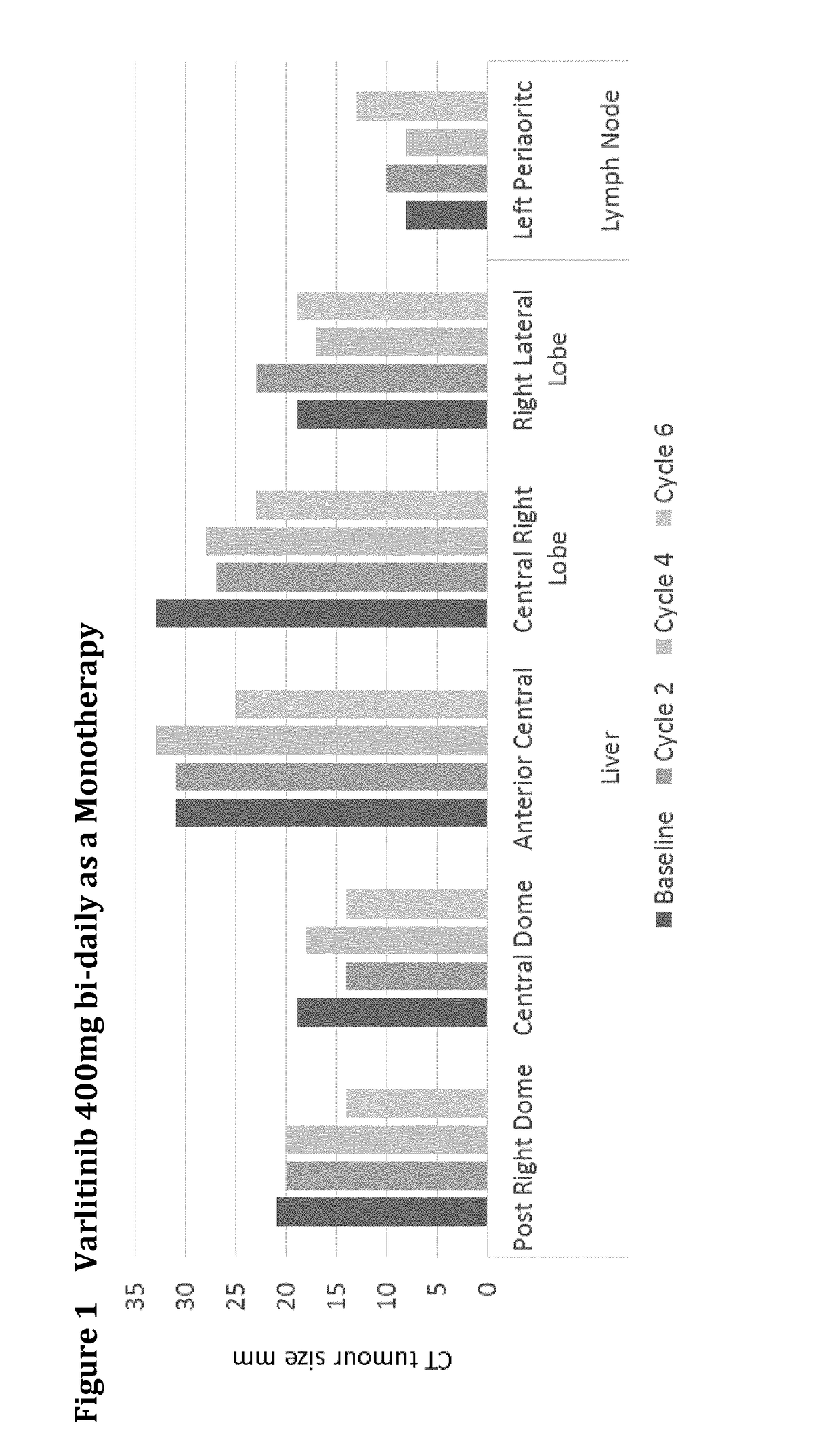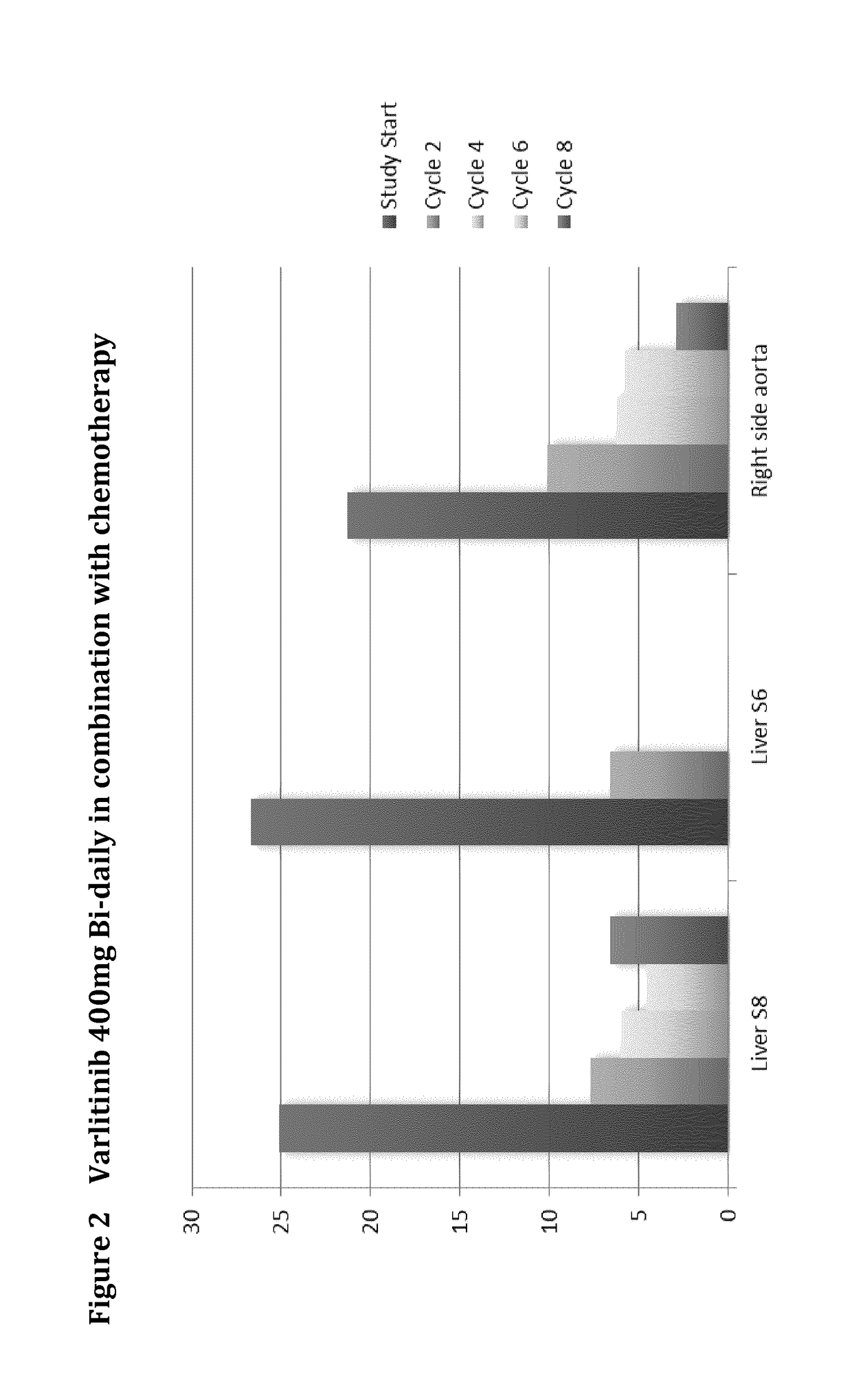Varlitinib for Use in the Treatment of Resistant or Refractory Cancer
a cancer and resistant technology, applied in the field of varlitinib for use in the treatment of resistant or refractory cancer, can solve the problems of limiting the therapeutic alternatives that are effective, losing their efficacy, and treating the patient's response to treatmen
- Summary
- Abstract
- Description
- Claims
- Application Information
AI Technical Summary
Benefits of technology
Problems solved by technology
Method used
Image
Examples
example 1
Varlitinib 400 mg Bi-Daily Monotherapy
[0171]A 45 year-old male stage IV cholangiocarcinoma EGFR positive (3+) cancer patient had progressive disease following:[0172]first line treatment with gemcitabine (partial remission), and[0173]second line treatment with cisplatin and 5-FU.
The results are shown in FIG. 1. After treatment cycle 6 with Varlitinib 400 mg bi-daily the liver tumours decreased in size up to 23% and the tumour marker CA 19-9 fell from ˜900 U / ml to ˜250 U / ml.
example 2
Varlitinib 400 mg Bi-Daily Combination Therapy
[0174]A 58 year-old, male, stage IV, extra-hepatic cholangiocarcinoma, prior treatment:[0175]Whipple[0176]Radiotherapy[0177]Gemzar / cisplatin for 6 months
For the first 6 cycles, the patient received Varlitinib 400 mg BID continuously with cisplatin (80 mg / m2 every 3 weeks) and capecitabine (1000 mg / m2 BID, 2 weeks on, 1 week off). Image scan at the end of cycle 6 showed 85.77% reduction in tumour size. After cycle 6, the patient received varlitinib monotherapy and tumor scan at the end of cycle 8 showed 87% reduction. This patient showed partial remission for 24 weeks. However, at the end of cycle 10, image scan showed tumour enlarged to the extent that met criteria for disease progression based on RECIST (>20% increase against nadir), so the patient was withdrawn from this study. In summary, the patient received varlitinib with chemo for 6 cycles and varlitinib monotherapy for another 4 cycles (3 weeks per cycle).
example 3
Treatment of Stage IV Intrahepatic Cholangiocarcinoma with Varlitinib 400 mg Bi-Daily Orally and FOLFOX
[0178]A 51 year-old female who had a medical history of meningioma post excision with left craniotomy was diagnosed with intrahepatic cholangiocarcinoma, stage IV with metastasis to portacaval lymph nodes and liver in August 2014. She received left hemihepatectomy followed by 6 cycles of adjuvant gemcitabine and cisplatin. The patient's disease progressed in May 2015 and she received 1st line gemcitabine and cisplatin in metastatic setting, to which he did not respond. After disease progression on gemcitabine and cisplatin, she was enrolled into the ASLAN001-002SG study in August 2015 and received Varlitinib 400 mg BID in combination with mFOLFOX6 (2 weeks per cycle). To date (22 Aug. 2016), the patient has completed 9 cycles of Varlitinib and mFOLFOX6, as well as, 9 cycles of varlitinib monotherapy and the latest tumor assessment completed after cycle 18 continues to show partial ...
PUM
| Property | Measurement | Unit |
|---|---|---|
| diameter | aaaaa | aaaaa |
| degree of resistance | aaaaa | aaaaa |
| resistance | aaaaa | aaaaa |
Abstract
Description
Claims
Application Information
 Login to View More
Login to View More - Generate Ideas
- Intellectual Property
- Life Sciences
- Materials
- Tech Scout
- Unparalleled Data Quality
- Higher Quality Content
- 60% Fewer Hallucinations
Browse by: Latest US Patents, China's latest patents, Technical Efficacy Thesaurus, Application Domain, Technology Topic, Popular Technical Reports.
© 2025 PatSnap. All rights reserved.Legal|Privacy policy|Modern Slavery Act Transparency Statement|Sitemap|About US| Contact US: help@patsnap.com



